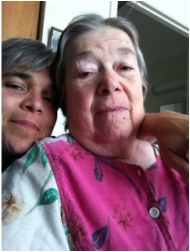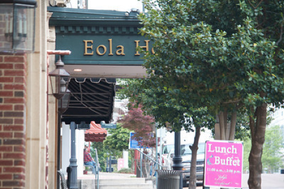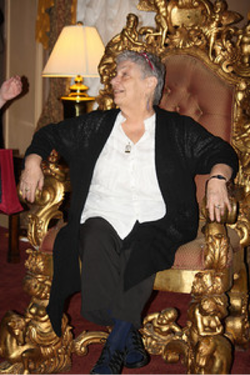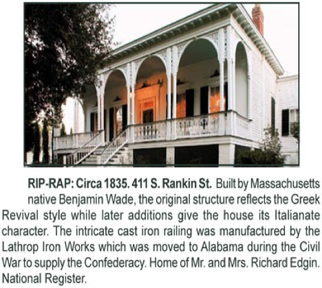 Tamara Jaffe-Notier, May 2014 “...all I know is that we've been fighting for marriage equality for years...we've come this close on more than one occasion..and then Tamara goes to Springfield, and, bam, we have marriage equality,” my friend David joked. It was fun to be part of the final push for marriage equality in Illinois. Oak Park Temple chartered a bus, and I was one of many aboard. Each person who marched, in the rain, on October 22, 2013, felt a little bit of the magic of the day. Many of us weren't convinced that Senate Bill 10, the “Religious Freedom and Marriage Fairness Act,” would be called for a vote any time soon—it had already been postponed once—but we still chanted with conviction, “gay, straight, black, white, marriage is a civil right.” Or something like that. We'd made our phone calls, and now we marched. The wind blew, and the rain came down. Some of us were “bearing the burden of the other,” and some of us were bearing our own burden. How did I, a gentile by birth and a Christian by culture, come to march with Oak Park Temple? Struggling to write this piece, I was accompanied by a memory of myself at 18, ironing shirts in the kibbutz laundry. The dry heat of the iron across the shirts smells good. In the distance I hear the goat-bells of the flocks tended by the Arab shepherds. My hands are wrapped in gauze bandages, recovering from lye burns and blisters from a reaction to the soap we used to scrub the kitchen floor, and a kibbutznik with a dark blue number tattooed on the inside of her wrist is yelling at me in Russian or Yiddish. She wears a small red lapel pin of the profile of Lenin. I can't shake her impression that I understand Russian. While the holocaust survivor yells at me, I see through the unscreened, open window above the ironing board that my friend Yuval is standing outside. He brings me an orange. I indicate the bandages on my hands, and he peels the orange for me, showing off, spiraling the peel into one long piece. Yuval tells me it’s a Jaffa orange, and smiles at his own joke. Yuval is wearing his Air Force uniform, and when the lady sees him she stops yelling. He's a pilot. He was born on this kibbutz, and she's known him his whole life. When she talks to Yuval in Hebrew I understand that she wants me to turn off the radio. I do. She smiles at us and walks away. She likes me because I enjoy working, maybe too much. Sometimes she tells me to slow down. Yuval explains that she doesn't like the Arabic music I was listening to on the local Nazareth station. He reminds me that I don't know what life was like here in the Galil when she escaped to Israel. To me, the Arabic music sounds like the music the Yemeni Jews played for entertainment at our ulpanim rendezvous campout.
Giving in to this memory brings up an earlier memory of sexy Shulamit Natan singing “Yerushalayim Shel Zahav.” When I was 8 years old I fell a little bit in love with Shulamit's beautiful face and her nervous, haunting voice, and I wanted to go to Jerusalem. I didn't know that this song was somewhat of an international hit, as a war ballad. I did not equate loving Jerusalem with patriotism. I memorized “Yerushalayim Shel Zahav” without understanding it. My parents bought that LP in Israel in 1970 at the “Conference on Biblical Prophecy.” Living on the kibbutz in 1980, I imagined that if I were a Jew I would stay in Israel. That would be where I belonged. But what do I know? We exist, in all of our tumultuous divisions. I choose Jews, Judaism, and Oak Park Temple because this community embodies who I am and who I wish to become. An important, but not well known, actor from Mound City, Illinois described this impulse that directs my conscious life: “You throw an anchor into the future you want to build, and you pull yourself along by the chain.” (John O'Neal)
1 Comment
Rachel Milstein, May 2014
While my grandparents joined the Temple in 1953, I, like my mother, grew up at Oak Park Temple. You could say that I have been involved since birth as I was given my Hebrew name in a Simchat Bat ceremony by Rabbi Gary Gerson and was a member of the Beatrice Glasser Nursery Schools’ second EVER class. In the mid 1990’s, my family was very close with Cantor Alane Katzew and her family. We went to museums, ball games, picnics/BBQs, birthday parties, Passover Seders, 4th of July fireworks and sleepovers as well as attended Shabbat services as an excuse to “hang out.” In a way, it gave me a sense of connection to the temple, since I knew the clergy on a personal level. At my bat mitzvah, in addition to the rabbi, the cantor gave me a blessing. She told my mother that in a way, it was preparation for her own daughter’s bat mitzvah, since she found herself emotionally moved at the time. When they moved away in 1997, it was a struggle to connect with the temple, as I had to get used to someone new. While I may not have stayed in touch with my preschool or religious school friends, as a camp counselor and teacher, I aimed to help the new generation of Temple youth keep in touch with each other. I wanted to make a difference. There was one Camp Shalom camper who had a special connection with me. When she was nearly 14, her mother told me that I was the sole reason her daughter identified with Judaism and Oak Park Temple. Even a simple hug or talk about her day had encouraged her daughter to connect with this Temple. As I embark on over 10 years of teaching Gan (kindergarten) in the religious school, I try to instill lasting friendships among my students, as I know that a connection with the Oak Park Temple community can influence them later in life. I sometimes feel isolated as a single woman among young families or long-standing members but I continue to be a part of Oak Park Temple to help others develop the connection that I once had as a child and hope to have in the future. Katie Frankle and David Goldman, 2013 A daughter’s dream and a furry suit brought us to Oak Park Temple.
After watching two cousins become B’nai Mitzvah, our eldest convinced us that she wanted to undertake the preparation and become Bat Mitzvah too. We had lived in Oak Park for a couple of years but were not yet members of a congregation; it was time to commit. We began exploring nearby choices and had attended services at two houses of worship when we arrived at Oak Park Temple on Purim. The members were friendly and pleasant. But we were not prepared for the rabbi to materialize on the bima wearing a squirrel costume, tail included, followed by the president of the congregation decked out as Fidel Castro, cigar in hand. Wow…a congregation with a sense of humor. We decided to give it a try We chose well. We found a meaningful spiritual center and have made many lifetime friends here. And as expected, we’ve had lots of fun within and through our affiliation with OPT. Both our children became B’nai Mitzvah and were confirmed at Oak Park Temple in meaningful ceremonies that brought our far flung families together for wonderful, joyous celebrations. And our daughter started down a path to her life calling here, now well on her way to becoming a rabbi herself. Katie Frankle – October, 2013
My favorite moment of the High Holidays occurs in the waning hours of Yom Kippur afternoon. Cantor Green’s voice has filled the sanctuary with the sacred beauty of Leonard Bernstein’s glorious music to the Twenty-Third Psalm. We have thumped our chests one last time asking forgiveness for our missteps of the past year. It is then that Paul Levin ascends the bima for the reading that has been his as long as I have been a member of Oak Park Temple. In his sonorous, basso profundo voice he begins: “The day is fading; the sun is setting; the silence and peace of night descend upon the earth…’ I gaze behind him and, indeed, the last rays of sunlight are shining through the stain glass windows that flank the Ark. A contemplative silence settles on the sanctuary as he recites the prayer book hope for a bright new year for humanity and the earth. It is a spiritual coda after ten days of prayer and reflection; I listen in a weakened state of hunger, before quotidian life begins anew. Shortly thereafter the Shofar is sounded; Rabbi Weiss savors a sip of wine, his first liquid in 24 hours, and extinguishes the Havdalah candle, marking the end of the High Holidays. I head home for sustenance cleansed and renewed.  MY AMAZING ADVENTURE IN NATCHEZ: A NORTHERNER’S INTRODUCTION TO SOUTHERN HOSPITALITY Dolly Baruch, April, 2011 On tour in the Deep South, checking out Jewish historical sites, synagogues, museums, civil rights history, and even some plantation mansions, with Rabbi Weiss and 23 members of the Oak Park Temple community, we stopped overnight in Natchez, Mississippi. We stayed at the Eola Hotel, a historic old place that advertises its “exuberant” décor. Antiques from the Victorian period plus a grand hall by an eclectic collection of museum quality antiques, original oil paintings, statuaries, and fountains.  That’s me on the throne in the raised lobby (there’s also a low level lobby as well). As is my wont, while this tour was tremendously interesting, educational, historical, and pleasing, I do like to get off by myself and check out what’s not on the agenda. So after I checked into the Eola and made tentative dinner plans with some friends, I went out to explore where we might have our meal. Two blocks up and down Main Street, there were numerous restaurants and cafes, and Breaud's Seafood & Steak looked promising. I read the menu on the window, they had food I could eat, the smells were great, and prices were reasonable. While I was reading the menu, a waitress came outside and invited me in – I said I was going back to my hotel and would be there later in the evening with some friends for dinner. On the way back to the hotel, I peeked into the Jack + Stella Boutique, a charming children’s clothing store. I shopped a little, but the prices were out of my pocketbook range. Then, as store was about to close, I asked the three women who were chatting just in front of the counter if there was a grocery store nearby that I could walk to so I could pick up some of the food I needed that I knew I probably couldn’t get in a restaurant (fat-free yogurt and fresh fruit) or where I was staying. “No,” they said, “no grocery store nearby to walk to, maybe a couple of miles but it’s too far to walk.” “But no worries,” one woman, a vivacious attractive woman a little younger than I whom I took to be the owner of the shop, “I’m just on my way to the grocery store myself to pick up a few things, and I’d be glad to take you there.” “Oh no,” I protested, “then you’d have to drive me back to the hotel. Or is there a taxi I could take?” “Oh, I’m sorry, I’m not letting you take a taxi. My car is around the corner. I’ll take you there and back. No trouble.” I let myself be persuaded, I really did need the food and there were no other open stores in sight, nor really, any traffic at all. A taxi would be a little much to expect in this small city at this time of the day. “I’m Brenda,” the woman said. “I’ll be back in a minute.” And she was. Brenda said she wanted to stop at the deli and we drove there chatting pleasantly about my tour and my plans for the evening. The deli was like nothing I’d ever seen in the north, really just a few shelves full of delicacies and a prepared food counter and a glass doored refrigerator. They didn’t have any apples, but there was a pint of freshly picked local strawberries – “We just got them from Pascagoula this morning.” I’d not a notion where Pascagoula was, but they were lovely strawberries that I couldn’t pass up (even at $5 a pint and they turned out to be sweet and juicy and just the right amount of firmness – kinda sexy). I asked if they had any fat-free yogurt at the counter where Brenda was buying some good looking freshly prepared dinners, but no, no yogurt at all. “Oh, that’s all right,” Brenda said. “I’ll take you to the Daisy Street Grocery, it’s on my way home.”  Then I felt really overwhelmed by her generosity and tried to say, no, never mind, I’ll just go back to the hotel, but Brenda was already on her way, parking out front and telling me exactly where I could find the yogurt in the story, “go straight back and turn to the left.” She was waiting for me in the parking lot as I paid for my food. “I’ll just take you on a little tour of Natchez on our way back to the hotel.” As we were driving, she told me she had a book signing coming up and that she had just stopped in the store to drop off some copies of her new book and wasn’t the owner at all. She had written her first children’s book, which was to be the first in a series of stories about her dog Winston and his adventures in Natchez. “That’d be perfect for my grandson. Where could I get one?” I asked. “At any gift shop in Natchez. But they’re all closed now. Mmmm, I have some at home. I’ll drop by there and you can get one.” Protesting all the way, we drove to her home, a beautiful mansion – she stopped here and there to wave to people, to just talk a little, and to introduce me to them. She also introduced me to her neighbors on each side of her home, keeping up a running commentary about each of them, where they’d come from, where they’d been, this one took the photographs of the dogs for her book, that one had a glorious garden. Her husband was home, not feeling well, her house was a mess (not true), her son was out, she’d hated dogs until she found Winston, whom she loved…and on and on, giving me a history of her town. Her home turned out to be on the Natchez Pilgrimage, the Rip Rap House, which reflects the Greek revival style while later additions give the house its Italianate character. We walked up the broad front steps but not before another neighbor dropped by, and we stood on the porch while Brenda introduced me to this neighbor and they conducted whatever business they had. By this time, I was totally overwhelmed, and getting quite anxious as I knew my dinner companions were probably waiting for me, and even though I had my cell phone with me, I’m such a tech dummy I didn’t think to call them to tell them I’d be late. Her house was filled with antiques – beautiful and tasteful (not at all the “exuberant” kind that the Eola Hotel had), and again, I was overwhelmed, this time by the stunning home of a complete stranger who’d done more for me than I’d ever expected. I’d no idea in the world that kind of hospitality existed. And while I’d been a tiny bit suspicious to begin with, thinking this was a little bit much generosity to sell a children’s book, seeing the home with the exquisite antiques led me to understand, this was a true example of southern hospitality. She called her dog in, so it could autograph my book with his paw dipped on an inkpad, and signed it to Bubie Dolly and Django. (http://www.amazon.com/Little-Winston-His-Adventures-Natchez) But not until then was she ready to drive me back to my hotel. She asked who my guide had been for the mansion tour. I retained the guide’s name (quite a feat for my leaky memory), Mary. “Oh Mary So-and-So, she’s a wonderful hostess.” And on the way, we just happened across Mary and her husband on their way out to dinner, so we just had to stop and talk a few minutes with them and see if she remembered me from earlier in the day. She had (or she said she did)! I guess the whole episode took about an hour and a half – and I had just wanted a 15 minute walk to clear my head and find a restaurant and a grocery store. When I got back to the hotel, my dinner companions were awaiting me – I had after all scouted out the restaurants for them, and we surprised the waitress at the Breaud by actually coming back. The waiter was adorable, the food was good, the prices were right, and later that evening, I had my Pascagoula strawberries and fat-free yogurt. An amazing adventure. An experience first hand of southern hospitality. A gift for my grandson Django. And a great story to relate on the long bus ride to the Rabbi and my tour companions the next day. What could be better? |
Our StoriesPeople
All
Archives
October 2015
|
 RSS Feed
RSS Feed
